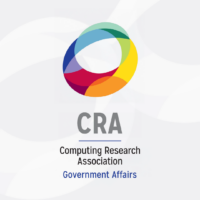NSF FY2025 Request: NSF Gets Another Good Budget Request but With Some Qualifications and Unknowns
By Brian Mosley, Associate Director, Government Affairs
The Biden Administration released their Fiscal Year 2025 requested budget on March 11th. As we have done in years past, the CRA Policy Blog will write a series of posts analyzing the assorted agency requested budgets that are important to the computing research community. First up is the agency that supports 78 percent of all Federally-supported basic research in computer science at academic institutions: the National Science Foundation. The Biden Administration proposes another strong budget for NSF. However, this year is a bit different. With a particularly bitter funding cut in Fiscal Year 2024, combined with the Fiscal Responsibility Act requirements on the overall Federal budget, the Administration is heavily constrained in their request. A perfect example of that is the fact that this year’s request for the agency is over a billion dollars less than what was submitted to Congress in NSF’s FY24 request.
A general note: NSF’s budget request was prepared before Congress finished its work on the agency’s FY24 budget. With that in mind, in the agency’s budget documents, you will see they compared the President’s request to FY23 (ie: the last year they had approved funding). Since CRA now has some, but not all, of the numbers for FY24, we will compare the President’s request against that. There are exceptions, most notably the assorted RRA directorates. Congress does not typically fund at that level, leaving it to NSF to decide how funding is exactly distributed. Since the agency has only had a finalized budget for a few weeks, we can only do a FY23 to FY25 request comparison for those parts of the agency.
Under the Administration’s FY25 plan, NSF would see a 12.1 percent increase compared to their FY24 budget approved by Congress earlier this month. NSF would go from $9.06 billion in FY24 to $10.2 billion in FY25, an increase of $1.14 billion. Research and Related Activities (R&RA), the subaccount that contains the funding for research grants, would see a sizable part of that increase, going from $7.18 billion in FY24 to $8.05 billion in FY25, a plus up of $870 million (or 12.1 percent). The STEM Education Directorate (EDU), which contains the agency’s education programs, would also see a sizable increase of $130 million, going from $1.17 billion in FY24 to $1.30 billion under the President’s FY25 plan; that’s an increase of 11.1 percent.
The requested budget would allow NSF to fund an estimated 36,200 research grants in FY25 (37,000 were funded in FY23), allowing for a 27 percent funding rate. The agency estimates that its activities will support a total of 357,100 people in FY25; that number includes senior researchers, other professionals, postdocs, graduate students, and undergrads.
| FY23 | FY24 | FY25 PBR | $ CHANGE | % CHANGE | |
| NSF Total | $9.90B | $9.06B | $10.20B | +$1.14B | +12.6% |
| R&RA | $7.80B | $7.18B | $8.05B | +$870M | +12.1% |
| EDU | $1.37B | $1.17B | $1.30B | +$130M | +11.1% |
| CISE | $1.04B | TBD | $1.07B | — | — |
| TIP | $664M | TBD | $900M | — | — |
CISE Directorate:
The Computer and Information Science and Engineering Directorate (CISE), located within R&RA, and the home for most of the computing research support at NSF, will receive an increase. It would go from an estimate of $1.04 billion in FY23 to $1.07 billion for FY25, an increase of $30 million or 2.9 percent. We do not yet have a budgetary number for CISE for FY24.
The CISE Directorate continues to, “play a leadership role,” in many NSF-wide initiatives, such as, “seminal investments in AI, advanced computing systems and services, quantum information science (QIS), advanced communications technologies, advanced manufacturing, semiconductors and microelectronics, biotechnology, and cybersecurity.”
As should surprise no one, artificial intelligence holds a prominent spot in the directorate’s request. CISE will continue to support the pilot NAIRR program with an initial budget of $30 million. The program is to, “amplify efforts across the federal government to cultivate AI innovation and advance trustworthy AI.” Additionally, the directorate will, “continued support for the National AI Research Institutes.” Tasked with establishing two additional AI institutes in the Biden Administration’s October executive order on AI, the directorate will also, “significantly broaden participation in AI research, education, and workforce development through capacity development projects such as ExpandAI, through CISE core investments, and through partnerships within the National AI Research Institutes ecosystem.”
In terms of the broadening participation and workforce development space, CISE, “in alignment with an agency-wide emphasis on Creating Opportunities Everywhere…will continue to invest in a broad suite of activities to support broadening participation in research and education.” For example, “the Broadening Participation in Computing Alliances (BPC-A) will serve as broad coalitions of institutions of higher education, K-12 schools, government, industry, professional societies, and other not-for-profit organizations that design and carry out comprehensive programs addressing underrepresentation in the computing and information science disciplines.” Additionally, the directorate will broaden participation in computing by, “increasing engagement in…research projects from MSIs through the CISE-MSI program and will emphasize education and training of more U.S. based students from diverse backgrounds through CISE Graduate Fellowships (CSGrad4US).” CSGrad4US is a CRA managed program that aims to increase the number of diverse, domestic graduate students pursuing research and innovation careers in the CISE fields: computer science, computer engineering, or information science.
Other major investments in the CISE request are Advance Wireless Research and Secure and Trustworthy Cyberspace (SaTC). With regard to the wireless research, the directorate will, “continue to invest in research in advanced wireless networks, building on its track record of enabling early-stage successes in 5G through ground- breaking millimeter-wave research,” and, “will accelerate research in areas with potential significant impact on emerging Next-Generation (NextG) wireless and mobile communications, networking, sensing, and computing systems, with a focus on greatly improving the resiliency and intelligence of such networked systems” With regard to SaTC, CISE will invest in, “current and emerging areas of importance for security and privacy,” including, “the application of AI to security, security and resilience of AI systems, security implications of quantum computation and communication, information integrity, and critical infrastructure security.” The directorate will also, “fund programs that strengthen the national cybersecurity workforce pipeline through education, K-12 programs, and funding to universities and colleges.”
TIP Directorate:
The Directorate for Technology, Innovation, and Partnerships, or TIP Directorate, enjoys continued priority in the President’s budget plans with a requested budget of $900 million for FY25, a 36 percent increase over its budget estimate for Fiscal Year 2023. We do not yet have a budgetary number for TIP for FY24.
TIP continues to receive special attention in the President’s budget roll out, as it figures heavily in the Administration’s priorities. In the president’s fuller budget plans, TIP is called out to as key to, “increase(ing) investments to translate the results of basic research into practical applications and processes that can benefit the Nation.” Within NSF’s justification document, TIP, “aims to usher in a new era for American innovation, accelerating research to impact and enhancing job and economic growth and national security for decades to come.” With that in mind, the directorate aligns its programs with three pillars: “nurtures new and diverse innovation ecosystems throughout” the nation; advance, “technology development across the range of key technology focus areas specified in the CHIPS and Science Act of 2022;” and create, “opportunities for everyone to engage in the nation’s R&D enterprise.”
With regard to the first pillar, nurturing new and diverse innovation ecosystems, the NSF Regional Innovation Engines (NSF Engines) features heavily. Tasked with, “catalyzing place-based innovation to spur economic and job growth,” particularly in places in the country that have, “not benefited from the technology and innovation booms of the last several decades.” The Engines program awarded the initial 10 awards spanning 18 states in January. Additionally, of the initial awards, “two are based in EPSCoR jurisdictions and nine include partners in an EPSCoR jurisdiction; nine include minority-serving institutions and all ten include community colleges; and four are led by industry and nonprofits.”
TIP also, “accelerates the translation of fundamental science and engineering discoveries into innovative new technologies and solutions.” Within this space, the directorate, “optimizes the historic NSF Lab-to-Market Platform, allowing researchers to pursue additional prototyping, demonstration, and scale-up work.” It also introduces, “new translation pathways…facilitating the adoption of NSF-funded research results as secure open-source ecosystems.” The TIP Directorate also, “supports the establishment and operation of testbeds to advance development, integration, deployment, and demonstration of breakthroughs in the key technology focus areas. TIP will also make major investments in artificial intelligence, quantum information sciences, advanced manufacturing, advanced wireless research, clean energy technology, and biotechnology; all these areas will receive significant increases in support, compared to their FY23 budgets.
Finally, the TIP Directorate, “creates opportunities for everyone to engage in the nation’s R&D enterprise.” It does this by working with, “academia, state, local, and tribal governments, industry, and other educational partners to provide practical experiences to diverse learners at every stage of education, from first-time job seekers to experienced workers.”
Conclusions:
For another year, President Biden has shown confidence in NSF and proposed a good budget for the agency. But the optimism of this year’s request should be tempered by the bad budget that precedes it. And it is important to keep expectations in check, as the political situation this year makes it highly unlikely that Congress will finish a budget on time, or even in this calendar year. The going view in Washington right now is that any final FY25 budget will arrive well after the election, with an endgame heavily influenced by the outcome of that election. It’s likely to be another long, difficult year. Please keep checking back for more updates.









